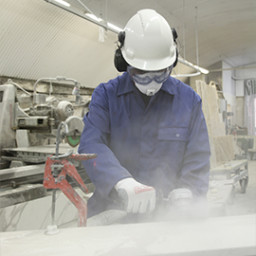Find an office location
More than 175 offices from coast to coast.

Crystalline forms of silica are known to cause silicosis, chronic obstructive pulmonary disease (COPD), lung cancer, and even kidney failure. Silica comes in many forms and is one of the most abundant materials found in the earth’s crust. Concrete contains up to 90% silica, as does concrete masonry unit (CMU) block, brick, sand and rock. Granite, including granite counter tops, can be over 40% silica. Silica is generally not hazardous unless it becomes airborne. Harmful exposures can happen when cured concrete and similar products are cut, drilled, chipped, and hammered. Any process that generates small airborne particles that can be inhaled is potentially hazardous. The new OSHA regulation focuses on protecting workers by limiting the amount of airborne dust workers can be exposed to.
The new OSHA Permissible Exposure Limit (PEL) is 0.05 milligrams of dust per cubic meter of air (mg/m3), which is several times lower than the previous PEL. In practical terms, this means if you can see airborne concrete dust, concentrations likely exceed the new PEL. (The author has conducted silica exposure assessments for activities including jack hammering, cutting, grinding, abrasive blasting, chipping, fracking, and more, and notes that it is more common than not to measure exposures above the new PEL when engineering controls aren’t being used).
The key feature of the new construction industry rule is found within Table 1. This table lists 18 common tasks and outlines specific control measures, timelines, and respiratory protection requirements. If an employer complies with all the requirements outlined in Table 1, they are not subject to the PEL. Requirements include installing water dust suppression or HEPA-filtered dust collection systems to protect workers using masonry saws, grinders, jackhammers, and drills.
For any tasks where exposure is possible but not identified in Table 1, employers are required to conduct an assessment to determine whether silica concentrations are above the Action Level, or half the PEL. If work areas are identified where exposures exceed the Action Level, a written silica exposure control plan will be required. Those employers who aren’t following the rule may be jeopardizing worker safety and making their companies targets for legal action. Keep in mind those class action lawsuits we’ve all seen for asbestos.
Moving forward, we encourage our clients to begin incorporating appropriate engineering controls and best practices into their projects now. Many construction firms have implemented proactive programs without workplace slowdowns. Being proactive also gives employers time to phase-in the purchase of new or upgraded equipment, such as wet saws or HEPA-filtered vacuum attachments. Construction firms and companies who proactively collaborate with their in-house health and safety teams and outside consultants can reduce potential downtime, as well as expenses related to implementation and compliance.
As we have seen with other regulatory roll-outs, many requirements outlined in the new silica standard can seem daunting. But once the initial apprehension has passed and companies commit to protecting the health of their biggest assets – their employees – silica best management practices will become routine and will support the long term success of their businesses.
Learn more about the new silica rule at https://www.osha.gov/silica/.
Article adapted from the April 2016 issue of Utah Construction & Design.
More than 175 offices from coast to coast.